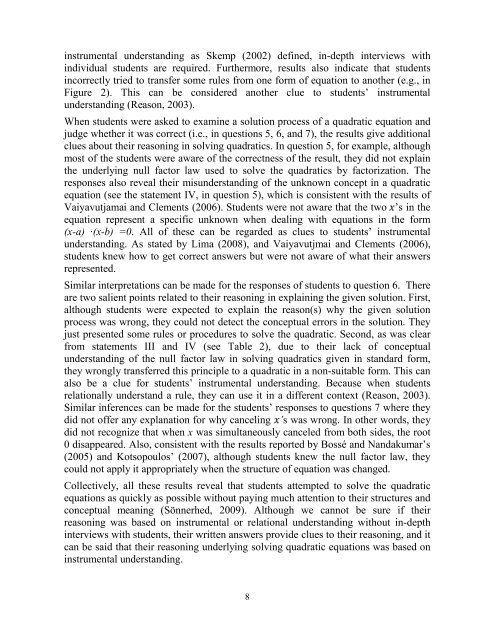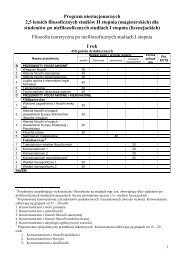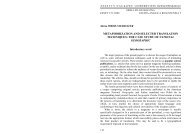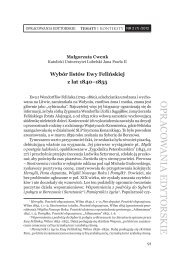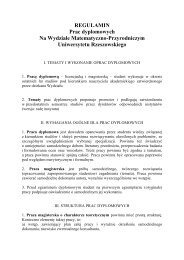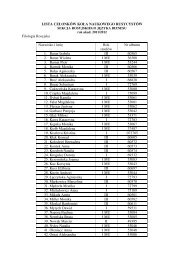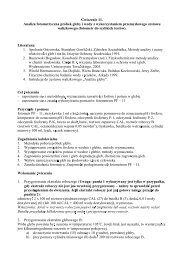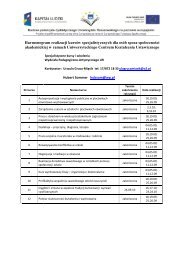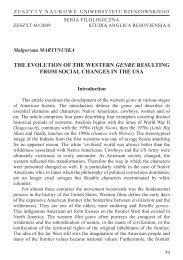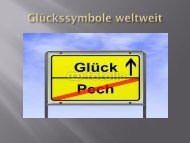reasoning in quadratic equations with one unknown - Cerme 7
reasoning in quadratic equations with one unknown - Cerme 7
reasoning in quadratic equations with one unknown - Cerme 7
Create successful ePaper yourself
Turn your PDF publications into a flip-book with our unique Google optimized e-Paper software.
<strong>in</strong>strumental understand<strong>in</strong>g as Skemp (2002) def<strong>in</strong>ed, <strong>in</strong>-depth <strong>in</strong>terviews <strong>with</strong><strong>in</strong>dividual students are required. Furthermore, results also <strong>in</strong>dicate that students<strong>in</strong>correctly tried to transfer some rules from <strong>one</strong> form of equation to another (e.g., <strong>in</strong>Figure 2). This can be considered another clue to students’ <strong>in</strong>strumentalunderstand<strong>in</strong>g (Reason, 2003).When students were asked to exam<strong>in</strong>e a solution process of a <strong>quadratic</strong> equation andjudge whether it was correct (i.e., <strong>in</strong> questions 5, 6, and 7), the results give additionalclues about their <strong>reason<strong>in</strong>g</strong> <strong>in</strong> solv<strong>in</strong>g <strong>quadratic</strong>s. In question 5, for example, althoughmost of the students were aware of the correctness of the result, they did not expla<strong>in</strong>the underly<strong>in</strong>g null factor law used to solve the <strong>quadratic</strong>s by factorization. Theresponses also reveal their misunderstand<strong>in</strong>g of the <strong>unknown</strong> concept <strong>in</strong> a <strong>quadratic</strong>equation (see the statement IV, <strong>in</strong> question 5), which is consistent <strong>with</strong> the results ofVaiyavutjamai and Clements (2006). Students were not aware that the two ’s <strong>in</strong> theequation represent a specific <strong>unknown</strong> when deal<strong>in</strong>g <strong>with</strong> <strong>equations</strong> <strong>in</strong> the form(x-a) ∙(x-b) =0. All of these can be regarded as clues to students’ <strong>in</strong>strumentalunderstand<strong>in</strong>g. As stated by Lima (2008), and Vaiyavutjmai and Clements (2006),students knew how to get correct answers but were not aware of what their answersrepresented.Similar <strong>in</strong>terpretations can be made for the responses of students to question 6. Thereare two salient po<strong>in</strong>ts related to their <strong>reason<strong>in</strong>g</strong> <strong>in</strong> expla<strong>in</strong><strong>in</strong>g the given solution. First,although students were expected to expla<strong>in</strong> the reason(s) why the given solutionprocess was wrong, they could not detect the conceptual errors <strong>in</strong> the solution. Theyjust presented some rules or procedures to solve the <strong>quadratic</strong>. Second, as was clearfrom statements III and IV (see Table 2), due to their lack of conceptualunderstand<strong>in</strong>g of the null factor law <strong>in</strong> solv<strong>in</strong>g <strong>quadratic</strong>s given <strong>in</strong> standard form,they wrongly transferred this pr<strong>in</strong>ciple to a <strong>quadratic</strong> <strong>in</strong> a non-suitable form. This canalso be a clue for students’ <strong>in</strong>strumental understand<strong>in</strong>g. Because when studentsrelationally understand a rule, they can use it <strong>in</strong> a different context (Reason, 2003).Similar <strong>in</strong>ferences can be made for the students’ responses to questions 7 where theydid not offer any explanation for why cancel<strong>in</strong>g ’s was wrong. In other words, theydid not recognize that when x was simultaneously canceled from both sides, the root0 disappeared. Also, consistent <strong>with</strong> the results reported by Bossé and Nandakumar’s(2005) and Kotsopoulos’ (2007), although students knew the null factor law, theycould not apply it appropriately when the structure of equation was changed.Collectively, all these results reveal that students attempted to solve the <strong>quadratic</strong><strong>equations</strong> as quickly as possible <strong>with</strong>out pay<strong>in</strong>g much attention to their structures andconceptual mean<strong>in</strong>g (Sönnerhed, 2009). Although we cannot be sure if their<strong>reason<strong>in</strong>g</strong> was based on <strong>in</strong>strumental or relational understand<strong>in</strong>g <strong>with</strong>out <strong>in</strong>-depth<strong>in</strong>terviews <strong>with</strong> students, their written answers provide clues to their <strong>reason<strong>in</strong>g</strong>, and itcan be said that their <strong>reason<strong>in</strong>g</strong> underly<strong>in</strong>g solv<strong>in</strong>g <strong>quadratic</strong> <strong>equations</strong> was based on<strong>in</strong>strumental understand<strong>in</strong>g.8


